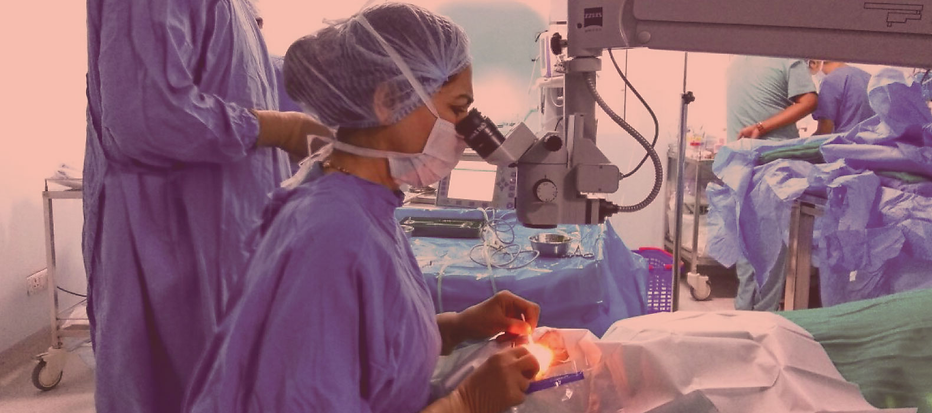
Cataract Surgery in Gurgaon
Cataract surgery in Gurgaon is a major part of our mission to be an institute of excellence in eye care services. It endeavors to provide world-class treatment to all sections of our society, with a focus on reversing the tide of curable blindness, in its area of operations in Delhi and surrounding townships.
With eyecare professionals of 30 years of exceptional service, we offer patients unparalleled eyecare and treatment options in order to get you seeing like you are young again. We welcome you to our locations and invite you to find out more about our highly trained medical staff, our outstanding facilities, and the treatment options available for cataract surgery in Gurgaon.
Arunodaya Deseret Eye Hospital is one of the leading eye hospitals for cataract surgery in Gurgaon located in Sector 55, Golf Course Road, where you can consult Dr. Reena Sethi, one of the most experienced cataract surgeon in Gurgaon Sector 55–56, Golf Course Road. The cost of cataract surgery in Gurgaon Sector 55 is quite affordable at ADEH. Contact us for more details.

WHAT WE DO ?
The Cataract & IOL Department is led by Dr. Reena Sethi, a leading cataract surgeon in Gurgaon (Head and Senior Consultant) who is supported by 5 more consultant surgeons trained in the management of cataract and general eye diseases, with the latest of technology in eye care available.
The team is also backed with cutting-edge technology and equipment, which enables them to achieve their targets and provide a very successful outcome. The use of Optical Biometery (TOMEY Japan), Latest phaco machinery (ALCON USA), best phaco dynamics (ALCON CENTURION System) and premium IOLs (Alcon, AMO, Zeiss and many others.) help the team meet expectations of their patients undergoing cataract surgery in Gurgaon.
Nuclear cataracts form in the middle of the lens and cause the nucleus, or the center, to become yellow or brown.
Nuclear cataracts
Cortical cataracts
Cortical cataracts are wedge-shaped and form around the edges of the nucleus.
Posterior capsular cataracts
Posterior capsular cataracts form faster than the other two types and affect the back of the lens.
Congenital cataracts
Congenital cataracts, which are present at birth or form during a baby’s first year, are less common than age-related cataracts.
Secondary cataracts
Secondary cataracts are caused by disease or medications. Diseases that are linked with the development of cataracts include glaucoma and diabetes.
Traumatic cataracts
Traumatic cataracts develop after an injury to the eye, but it can take several years for this to happen.
All these are effectively treated through cataract surgery in Gurgaon at our facility.

KEY FACTORS & FIGURES
50000+
Surgeries
25+ Years
PHACO
MICS
Available
TORIC Correction
For
ASTIGMATISM
Premium
IOS
WHAT OUR PATIENTS SAY

MONOFOCAL IOL
These are the standard intraocular lenses and can correct vision according to one focusing distance - nearsightedness, far and immediate. We offer a wide range of brands of IOLs for patients to choose from.
MULTIFOCAL IOL
Multifocial IOL can correct multiple errors in the eye. It allows a more clear vision compared to monofocal IOL. Visual action is analogous to Monofocal IOL for far vision. Eyeglasses for near vision are not required.
TORIC LENSES
Toric lenses considered to correct a patient’s astigmatism and blury vision. Toric lenses are frequently considered as “special” or “premium” because they provide several vision enhancing benefits.
These lens types are offered as part of cataract surgery in Gurgaon at our center.
Advanced Techniques for Cataract Surgery in Gurgaon
At Arunodaya Deseret Eye Hospital, Gurgaon, we believe that innovation leads the way in cataract treatment. Our team consistently adopts the most advanced surgical techniques—ranging from Phacoemulsification to Minimally Invasive Cataract Surgery (MICS) and Blade-free Femto LASER-assisted procedures.
We also offer premium Multifocal and Extended Depth of Focus (EDOF) intraocular lenses (IOLs), allowing patients to enjoy clear vision at multiple distances—perfect for reading, computer work, and mobile use, often without needing glasses.
With a commitment to cutting-edge care and excellent outcomes, ADEH continues to set the standard for cataract surgery in Gurgaon.
Your Trusted Cataract Surgeons in Gurgaon
At Arunodaya Deseret Eye Hospital, Gurgaon, we are proud to offer the highest standards of eye care with a team of expert cataract surgeons in Gurgaon. Specializing in advanced cataract surgery in Gurgaon, our specialists use state-of-the-art techniques like Phacoemulsification and Blade-Free Femto LASER-assisted procedures. We customize each treatment with the latest intraocular lenses (IOLs) to restore sharp, clear vision. For trusted care and precision-driven outcomes, Arunodaya Deseret Eye Hospital is your go-to destination for cataract surgery in Gurgaon.
Cost of Cataract Surgery in Gurgaon
The cost of cataract surgery in Gurgaon can vary depending on the type of procedure, the technology used, and the intraocular lens (IOL) selected. At Arunodaya Deseret Eye Hospital, we offer personalized treatment plans that balance advanced technology with affordability, ensuring the best visual outcomes for every patient. Whether you’re considering standard or bladeless laser-assisted options, our team provides transparent guidance on all aspects of the cataract surgery cost in Gurgaon, helping you make an informed decision with confidence.
WRITE TO US











